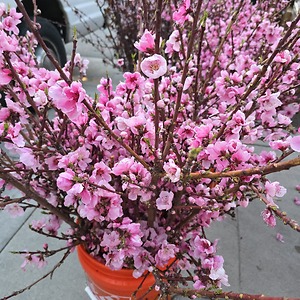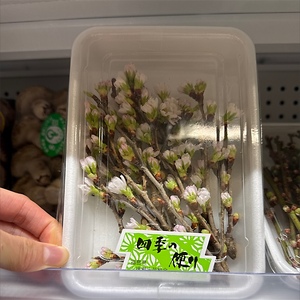


Japanese Cherry Blossoms
Estimated Inventory, lb : 0
Description/Taste
Japanese Cherry blossoms vary in size, shape, coloring, and overall appearance, depending on the specific variety. The blooms develop on short stalks extending from dark brown-grey, woody branches, and each blossom showcases a single or double row of petals in white, light pink, dark pink, and variegated tones. The petals are typically soft, delicate, papery, broad, curved, oval, cordate, or tapered in shape. Each variety will also have a center filled with anthers and filaments. For culinary use, Japanese Cherry blossoms are only harvested when they are buds or partially opened and have not fully bloomed. The blossoms are edible raw and have a very mild, subtly sweet, floral, and almond-like flavor. Japanese Cherry blossoms are also salted and preserved, enhancing their aroma, creating a pleasant, rose-like scent that becomes concentrated after salting. Beyond the flowers, some young, green leaves of specific Japanese Cherry blossom varieties are edible as they are soft and smooth. Research should be conducted before eating any Cherry blossom in the wild, as not all species under the general Japanese Cherry blossom name are edible. Most retailers should distinguish between edible and non-edible species, but care must still be taken to be educated before eating.
Seasons/Availability
Japanese Cherry blossoms are available from late winter through spring, with different varieties blooming at various points throughout the season. Most varieties appear in late March through mid-May.
Current Facts
Japanese Cherry blossoms, botanically a part of the Prunus genus, represent a broad category of edible and ornamental flowering trees belonging to the Rosaceae family. Worldwide, there are between 2,000 and 3,000 varieties of flowering cherry trees, and approximately 100 species are planted throughout Japan. Flowering Cherry trees are treasured markers of spring in Japan, and some wild species have been present throughout the countryside for thousands of years. Within the Japanese Cherry blossom category, some species are utilized for culinary purposes, and some are primarily ornamental. For the purposes of this article, only the varieties considered edible are being discussed. Cherry blossoms are known as Sakura in Japan and are deeply intertwined with Japanese cultural and culinary traditions. Someiyoshino is regarded as the most famous Cherry blossom variety in Japan. This hybrid cultivar is technically edible but is said not to have a pleasing flavor. It is mainly grown as an ornamental. Sekizan, or Double Cherry blossoms, Yaezakura, and Kanzan are well-known edible blossom cultivars. Oshima is a prized variety for harvesting edible leaves. The blooming of Japanese Cherry blossoms is one of the most anticipated seasonal events in the spring, and the fleeting nature of the blossoms encourages chefs to be creative in preserving the blooms and leaves for year-round use.
Nutritional Value
Cherry blossoms have not been extensively studied for their nutritional properties. The blossoms are said to contain anti-inflammatory and antioxidant properties to reduce inflammation and protect the cells against free radical damage. They are also reported to contain tiny amounts of vitamins E, B, and A. Salted Cherry blossoms develop a polyphenol called coumarin, a compound that contributes to the blossom’s aroma. Coumarin is created when the salt breaks down sugar in the blossoms and is said to have a calming effect on the mind while improving blood flow. It is important to note that Cherry blossoms should not be consumed in large quantities as they can be mildly toxic in overwhelming doses. Historically, Cherry blossoms and leaves were infused into various topical beauty products and medicines in Japan. The blossoms were said to help brighten skin tone, reduce redness, and improve overall complexion.
Applications
Japanese Cherry blossoms have a mild, subtly sweet, and almond-like taste suited for raw and cooked preparations. The delicate, fresh blossoms can be used as a garnish on top of cocktails and other beverages or to decorate various desserts. Japanese Cherry blossoms are only in season for a few weeks, and the blooms have a short shelf life when fresh. The blossoms are traditionally salted and infused into plum vinegar for extended storage. Salted Cherry blossoms can be stored for over one year and the process of salting the blooms allows the moisture to be removed, creating an aromatic compound that becomes concentrated. This compound is what gives various dishes its signature Cherry blossom scent and flavor. In Japan, Hadano City in the Kanagawa Prefecture is the top producer of salted Cherry blossoms, and production dates back to the Edo Period, from 1603 to 1868 CE. Salted Cherry blossoms can be reconstituted with water and sipped as tea, fried into tempura, mixed into noodle and rice dishes, soaked into honey to drizzle on cheeses, yogurt, or tea, or layered as a garnish or base for sushi and sashimi. Some Japanese beer companies infuse select product lines with Cherry blossoms and seasonal cocktails use the salted blooms for enhanced aroma and flavoring. In addition to salted preparations, Japanese Cherry blossoms are popularly incorporated into desserts. The blossoms are used to flavor macaroons, rolled cakes, steamed bread, and blancmange, a cold dessert of salted Cherry blossoms and sweetened milk. They are also added to three-colored dango, a glutinous rice flour rolled into a dough and pierced onto skewers. The three-colored dango symbolizes the changing of the seasons and the colors of the Cherry blossoms. The first dough ball is pink, the second is white, and the third is green. Beyond the blossoms, some varieties of Japanese Cherry blossoms have edible leaves and are used in Sakura mochi, a rice cake wrapped in pickled cherry blossom leaves and filled with red bean paste. Wood pieces from the trees can also be smoked and used to flavor dishes. Japanese Cherry blossoms should be used immediately for the best quality and flavor. Preserved and salted blooms will keep up to one year.
Ethnic/Cultural Info
Cherry blossom viewing is a Japanese springtime tradition called Hanami or Ohanami. The annual practice typically involves families and friends intentionally gathering for social events under the flowering Cherry blossom trees. It is customary for gatherings to include picnics, and viewing the beauty of the trees is a reminder of starting fresh in the spring. During Cherry blossom season, the blooms are also preserved in salt and made into Sakura yu, which translates to “Cherry blossom tea.” Sakura yu is an herbal tea made from pickled blossoms and boiling water. The tea has been made since the Edo Period and is an auspicious beverage to serve at weddings, birthdays, engagements, and other special events. Sakura yu is viewed as lucky, and at weddings, its clear nature is seen as good luck for the couple to have a clear and not cloudy marriage. Other types of tea are abstained from if they have a hazy appearance. In Japan, the name Sakura is derived from the name of the god of rice fields, “Sa-kami,” which descended on villages when the Cherry blossom trees bloomed. The presence of the god acted as a hope for prosperity, and the fleeting nature of the blooms is an annual reminder of the brevity of life.
Geography/History
Wild species of Cherry blossoms have been present in Japan since ancient times. Much of the history of Cherry blossoms is unknown, but several types of wild species occur in various forests throughout the country. Cherry blossoms have marked the arrival of spring in Japan for centuries. In the Heian Period, 794 to 1185 CE, Cherry blossom trees were selected for cultivation to create improved varieties, and the trees were planted along riverbanks to prevent erosion, sown in home gardens and public spaces, or planted in temples. Later, during the Edo Period, 1603 to 1868 CE, a variety known as Someiroshino was developed and quickly became one of Japan's most recognizable and popular varieties. Today, many varieties of Cherry blossoms have been cultivated domestically in Japan or introduced into the country from regions of the Western world. The name Japanese Cherry blossom encompasses edible and ornamental varieties. Edible Cherry blossoms are grown across Japan and are seasonally harvested for their blossoms and leaves. When in season, Cherry blossoms are sold through select farmers' markets and high-end retailers. The blossoms are also preserved and sold in various culinary goods year-round through online retailers, distributors, and specialty grocers.
Recipe Ideas
Recipes that include Japanese Cherry Blossoms. One
| Hyper Allergic |
|
Cherry Blossom Eau-de-vie |
| Hyper Allergic |
|
Preserved Cherry Blossoms |









